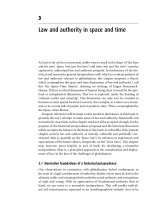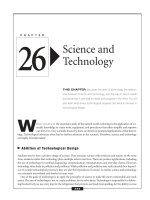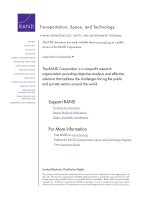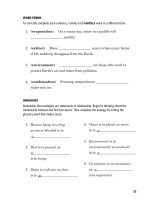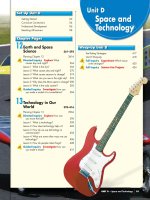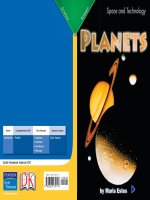telescopes space and technology
Bạn đang xem bản rút gọn của tài liệu. Xem và tải ngay bản đầy đủ của tài liệu tại đây (5.07 MB, 14 trang )
Scott Foresman Science 5.16
Genre Comprehension Skill Text Features Science Content
Nonfi ction Summarize • Labels
• Captions
• Diagrams
• Glossary
Stars and Galaxies
ISBN 0-328-13963-7
ì<(sk$m)=bdjgdh< +^-Ä-U-Ä-U
13963_01-04_CVR_FSD.indd Cover113963_01-04_CVR_FSD.indd Cover1 5/13/05 12:55:17 PM5/13/05 12:55:17 PM
Scott Foresman Science 5.16
Genre Comprehension Skill Text Features Science Content
Nonfi ction Summarize • Labels
• Captions
• Diagrams
• Glossary
Stars and Galaxies
ISBN 0-328-13963-7
ì<(sk$m)=bdjgdh< +^-Ä-U-Ä-U
13963_01-04_CVR_FSD.indd Cover113963_01-04_CVR_FSD.indd Cover1 5/13/05 12:55:17 PM5/13/05 12:55:17 PM
1. Explain the different ways in which convex
and concave lenses bend light.
2. What is the advantage of the radio telescope?
3. What is a planisphere? How can it help
amateur astronomers?
4.
Galileo made important
discoveries using his refracting telescope.
Write to explain the signifi cance of his
discoveries. Include details from the book
to support your answer.
5.
Summarize Astronomers faced diffi culties
after the Hubble telescope was launched into
space. Summarize the problem and how it
was solved.
What did you learn?
Extended Vocabulary
concave
convex
infrared light
pulsar
quasar
refl ecting telescope
refracting telescope
Vocabulary
black hole
constellation
galaxy
light-year
nebula
supernova
Picture Credits
Every effort has been made to secure permission and provide appropriate credit for photographic material.
The publisher deeply regrets any omission and pledges to correct errors called to its attention in subsequent editions.
Photo locators denoted as follows: Top (T), Center (C), Bottom (B), Left (L), Right (R), Background (Bkgd).
Opener: Human Space Flight/NASA; 1 Science Museum, London /DK Images; 2 Human Space Flight/NASA; 3 ©Anglo-
Australian Observatory/DK Images; 5 Robin Scagell/©Galaxy Picture Library; 9 (T) Damian Peach/©Galaxy Picture
Library; 10 (TR) Science Museum, London /DK Images; 11 (TL) NASA; 12 Charles Walker / Topfoto /The Image Works,
Inc.; 13 John and Lisa Merrill/Corbis; 14 ©Roger Ressmeyer/Corbis; 15 ©Roger Ressmeyer/Corbis; 16 Human Space
Flight/NASA; 18 (B) Lester Lefkowitz/Corbis; 19 (TR) NRAO/AUI/©Galaxy Picture Library; 21 (TR) Bob Garner/©Galaxy
Picture Library; 23 NASA.
Unless otherwise acknowledged, all photographs are the copyright © of Dorling Kindersley, a division of Pearson.
ISBN: 0-328-13963-7
Copyright © Pearson Education, Inc. All Rights Reserved. Printed in the United States of America.
This publication is protected by Copyright, and permission should be obtained from the publisher prior to any
prohibited reproduction, storage in a retrieval system, or transmission in any form by any means, electronic,
mechanical, photocopying, recording, or likewise. For information regarding permission(s), write to
Permissions Department, Scott Foresman, 1900 East Lake Avenue, Glenview, Illinois 60025.
3 4 5 6 7 8 9 10 V010 13 12 11 10 09 08 07 06 05
13963_01-04_CVR_FSD.indd Cover213963_01-04_CVR_FSD.indd Cover2 5/13/05 12:55:38 PM5/13/05 12:55:38 PM
by Barbara Fierman
13963_05-28_FSD.indd 113963_05-28_FSD.indd 1 5/10/05 3:27:06 PM5/10/05 3:27:06 PM
For centuries people have been interested in events seen in
the sky. They invented tools such as the astrolabe, the sextant,
and the telescope, and they built observatories to help them
explore the universe.
Early astronomers, such as Galileo and Newton, used simple
telescopes. These used mirrors and glass to make the stars appear
closer. Telescopes used today are much bigger and more powerful
than early ones. Radio telescopes have bowl-shaped dishes that pick
up radio waves given off by distant objects in space. Space
telescopes, such as the Hubble, are launched into space beyond
Earth’s atmosphere, where viewing conditions are dark and clear.
Our Sun is a star. It is the closest star to Earth. A star is a giant
ball of very hot gases that gives off heat and light energy. A star’s
size, temperature, and distance from Earth affect how bright a star
looks to us, and its color tells us how hot it is.
Hubble Space Telescope
2
What You Already Know
13963_05-28_FSD.indd 213963_05-28_FSD.indd 2 5/10/05 3:27:10 PM5/10/05 3:27:10 PM
Telescopes have allowed scientists to measure a star’s distance
from Earth in light-years. A light-year is the distance light travels in
one year, which is more than 9 trillion kilometers. Telescopes have
also allowed scientists to observe the birth and death of stars. New
stars form in a cloud of gas and dust called a nebula. When some stars
are at the end of their lives, they make a gigantic explosion called a
supernova. After this, stars sometimes become black holes, or points
in space with so much gravity that not even light can escape them.
The Sun, Earth, and the other planets in the solar system are part
of a galaxy, or a huge system of stars, gases, and other material held
together by gravity. Scientists divide the galaxy into eighty-eight areas
called constellations.
Since their invention about four hundred years ago, telescopes
have helped scientists learn many new things about the night sky. Now
let’s learn more about telescopes.
3
This supernova was observed through a telescope.
13963_05-28_FSD.indd 313963_05-28_FSD.indd 3 5/10/05 3:27:13 PM5/10/05 3:27:13 PM
4
Look Up
For thousands of years, people have been fascinated by the
night sky. Ancient peoples built observatories where they plotted
the movements of the stars and planets. Since then, astronomers,
or scientists trained to study space, have explored the stars and
planets to learn more about our galaxy and beyond. The
invention of the telescope in the 1600s greatly improved
astronomers’ ability to study space.
A telescope is an instrument that allows a viewer to observe
distant objects. Since a telescope magnifi es objects, viewers can
observe, study, and take photographs of distant features in
the night sky. Early telescopes used glass
lenses or mirrors to collect and
change light and focus images.
This viewer uses a telescope
mounted on a tripod to view
and study objects in space.
13963_05-28_FSD.indd 413963_05-28_FSD.indd 4 5/10/05 3:27:17 PM5/10/05 3:27:17 PM
5
The fi rst telescope was
invented in the 1600s. It consisted of
a long tube with a glass lens that gathered
light at one end and an eyepiece that magnifi ed
the image at the other end. This is called a refracting telescope.
It allowed people to see farther into space than ever before.
But there were many more technological advances to come.
An improvement on the refracting telescope was the refl ecting
telescope. This type of telescope used a curved mirror instead
of a glass lens. It is easier to build large refl ecting telescopes than
large refracting telescopes.
After World War II, a new type of telescope was developed.
The radio telescope picked up radio waves given off by stars,
planets, and other objects in space. By 1990 technology made
it possible to launch telescopes out into space. This allows
telescopes to deliver much clearer images because the light
from distant objects does not pass through Earth’s atmosphere
before entering the telescope. When light passes through the
atmosphere, some of it gets blocked. This makes objects in space
harder to see.
Today, many types of telescopes are available. They come in
different sizes, ranging from small telescopes used by viewers
in their backyards to huge telescopes housed in observatories or
orbiting Earth.
Telescopes allow us to see
the stars and planets with
more detail. Without a
telescope, they look just
like tiny points of light.
13963_05-28_FSD.indd 513963_05-28_FSD.indd 5 5/10/05 3:27:19 PM5/10/05 3:27:19 PM
Telescope Science
Telescopes work by bending light. Some telescopes do
this with lenses. Light bends when it enters the glass of a lens.
This is called refraction. Different types of lenses use refraction
to either focus or spread out light. Convex lenses are thicker in
the middle than at the edges, and their surfaces are curved like
domes. A wide beam of light entering a convex lens will be
focused to a very small point.
Concave lenses are thicker at their edges than in their middles.
Their surfaces curve inward, like bowls. They spread narrow
beams of light into wider beams.
A convex lens is thicker
in the middle than at the
edge. This type of lens
focuses light.
A concave lens is thinner
in the middle and thicker
at the edge. A concave
lens spreads out light rays.
6
13963_05-28_FSD.indd 613963_05-28_FSD.indd 6 5/10/05 3:27:23 PM5/10/05 3:27:23 PM
Mirrors can also be used to focus or spread out light. They do
this by refl ecting light instead of bending it. Convex mirrors have
a dome-shaped surface that spreads light. Picture dropping
a rubber ball on an upside-down bowl. The ball would bounce
outward, away from the bowl’s center. This is what happens to
each ray of light that strikes a convex mirror.
Concave mirrors have a surface that curves inward. They
focus light. Picture dropping a rubber ball into a bowl that is
sitting right-side up. The ball would bounce inward, toward the
bowl’s center. This is how a concave mirror focuses light rays.
Convex mirrors refl ect light in
all different directions, spreading
it out.
Concave mirrors refl ect light rays
in toward their center, focusing
them to a point.
7
13963_05-28_FSD.indd 713963_05-28_FSD.indd 7 5/10/05 3:27:24 PM5/10/05 3:27:24 PM
Refracting Telescopes
Refracting telescopes use lenses to
make images appear larger. They consist
of a tube with a lens at each end. The
fi rst lens, called the objective lens,
gathers and focuses light. The viewer
looks through the second lens, called
the eyepiece lens. It magnifi es the image.
The fi rst refracting telescope was
invented by a Dutch eyeglass maker in
1608. Soon after, the great astronomer
Galileo Galilei built a telescope that
could magnify images to twenty times
their actual size. One problem with
Galileo’s refracting telescope was that
the colors of objects would appear a little
off. Another problem was that images
were blurred or fuzzy. These problems
were reduced by using wide, thin lenses.
But the wider a lens is, the longer a
telescope has to be to make it focus
properly. Also, very large lenses are very
heavy. If a lens is too large, it will start to
bend under its own weight, which changes
the shape of images.
8
eyepiece lens magnifi es the image
viewer
This diagram shows the
path of light through a
refracting telescope.
Modern refracting telescopes
are far more powerful than
Galileo’s telescope.
13963_05-28_FSD.indd 813963_05-28_FSD.indd 8 5/10/05 3:27:28 PM5/10/05 3:27:28 PM
Galileo was the fi rst person to use a telescope to study the
night sky. Between 1610 and 1619, he made several important
discoveries. Galileo discovered that the Milky Way galaxy was
made up of many stars, and that each star was at a different
distance from Earth. When he observed the Sun, he saw many
spots on it. When viewing the Moon, he noticed mountains and
craters. At that time, people believed that the Moon was a perfectly
smooth ball, and Galileo proved that it wasn’t.
Galileo observed four moons orbiting the planet Jupiter. He
also discovered that the planets Mercury and Venus revolve
around the Sun. At that time, people believed that Earth was the
center of the universe. Galileo’s discoveries led to his conclusion
that the Sun was actually the center of the solar system. His idea
was not accepted for many years.
In 1613 Galileo became the fi rst astronomer to spot the
planet Neptune, which he thought was a star. It wasn’t until 1846,
more than two hundred years later, that scientists realized that
Neptune was a planet. Galileo’s many important discoveries led
to the building of better and more powerful telescopes.
9
In 1610 Galileo discovered
the phases of Venus with
his telescope. Its phases are
similar to the Moon’s.
Objective lens collects light.
Phases of Venus
light
13963_05-28_FSD.indd 913963_05-28_FSD.indd 9 5/10/05 3:27:32 PM5/10/05 3:27:32 PM
Refl ecting Telescopes
An English scientist, Sir Isaac
Newton, discovered that the lenses
of refracting telescopes split light into
different colors. This made images
blurry. Newton’s solution to the
problem was to use mirrors instead of
lenses. Mirrors do not split light. The
result of his work was the invention of
the refl ecting telescope.
Newton’s refl ecting telescope had
a concave mirror at one end of a tube
and a fl at, tilted mirror in the center,
near the other end. Light entered one
end of the telescope and traveled to the
other end, where it struck the concave
mirror. This mirror gathered the light
and focused it on the fl at, tilted mirror.
The tilted mirror refl ected light out
through a hole in the side of the tube
and into an eyepiece.
10
large concave mirror
Refl ecting telescopes have
a large concave mirror that
collects and concentrates
light. A second mirror refl ects
the light to the user’s eye.
Newton invented the
fi rst refl ecting telescope.
13963_05-28_FSD.indd 1013963_05-28_FSD.indd 10 5/10/05 3:27:34 PM5/10/05 3:27:34 PM
Newton’s telescope had several advantages over the refracting
telescopes in use at the time. Mirrors were much easier to make
than lenses. A lens must be made of very high quality glass with
no bubbles in it. Also, a lens has two surfaces that must be
perfectly shaped to give a clear image. A mirror has only
one surface to shape and polish.
Newton’s telescope was also very
powerful for its size. This was an advantage
because large refracting telescopes did not
work very well. To make a refracting
telescope more powerful, the lenses had to
be moved farther apart. Telescopes were
built longer and longer, until some reached
over forty meters! With such long
telescopes it was almost impossible to keep
the lenses lined up correctly. Refl ecting
telescopes did not have this problem.
11
plane mirror
Uranus
William Herschel built refl ecting
telescopes using Newton’s design.
Using a twelve-meter-long
refl ecting telescope, he discovered
Uranus in 1781. Later he discovered
two of its moons.
Uranus
light
13963_05-28_FSD.indd 1113963_05-28_FSD.indd 11 5/10/05 3:27:39 PM5/10/05 3:27:39 PM
Observatories
In ancient times, astronomers wanted dry, warm places to sit
while they observed the night sky. The ancient Greeks and
Babylonians built simple buildings for viewing the stars. These
buildings were the fi rst observatories. In more recent times,
observatories have been built far from cities. These locations are
very dark, making it easier to see the faint light of distant stars.
Some observatories are built on high mountaintops. When
telescopes are built in higher locations, light travels through less
of the atmosphere before reaching them. This allows more light
to get to the telescopes.
In the 1600s observatories were built to house refracting
telescopes. The Paris Observatory, in Meudon, France, opened in
1670. In 1675 the King of England set up the Royal Greenwich
Observatory in Greenwich, England. There, astronomers created
star charts to help sailors navigate on the seas.
In the 1800s other types
of equipment, such as
cameras, became important
tools in observatories. By
the end of the 1800s, huge
refracting telescopes were
being built. Special buildings
with domes on top were built
to house these telescopes.
12
This early observatory
was built in India in
1726. It enabled early
astronomers to study the
sky with the naked eye.
13963_05-28_FSD.indd 1213963_05-28_FSD.indd 12 5/10/05 3:27:43 PM5/10/05 3:27:43 PM
The Mauna Kea observatory is located on the island of
Hawaii. It is the largest observatory located on a mountain’s
summit in the world. Mauna Kea contains thirteen telescopes,
which include both optical and radio telescopes. Two of the
largest optical telescopes in the world, Keck I and Keck II, are
located in the observatory at Mauna Kea. Astronomers from
eleven different countries operate the telescopes.
Mauna Kea is actually an inactive volcano on the largest
of the Hawaiian Islands. It is the highest island mountain in the
world, rising 4,205 meters above sea level. The atmosphere above
Mauna Kea is very dry and free of clouds. As a result, there are
more clear nights there than almost anywhere else in the world.
Since its location is far from cities, there are no lights to interfere
with the telescopes’ view. The dark skies allow astronomers to
view dim galaxies that lie at the edge of the universe.
13
Mauna Kea observatory
in Hawaii is built on top
of a very tall mountain.
Its height and clear
weather provide an
excellent view of the sky.
13963_05-28_FSD.indd 1313963_05-28_FSD.indd 13 5/10/05 3:27:48 PM5/10/05 3:27:48 PM
Telescopes Today
If more light reaches a telescope, the image will be brighter.
Bigger telescopes let in more light, so bigger telescopes are better.
Until the end of the 1800s, very large telescopes had been
refracting telescopes. The problems of earlier refracting telescopes
had been corrected by using complicated systems of lenses. But
there was a limit to how large a lens could be made. Since high-
quality mirrors could be made larger than lenses could, refl ecting
telescopes became the preferred choice.
The Keck telescopes in the Mauna Kea observatory in Hawaii
are some of the largest refl ecting telescopes in the world. Each
of the Keck mirrors consists of thirty-six smaller mirrors. All
together, they make up a single mirror 10 meters across. This
is called a segmented mirror. Why not just build one large
mirror? Small mirrors are easier to make than large ones. They are
also lighter, so they don’t bend under their own weight and don’t
change the images.
14
The Keck telescopes in Hawaii
each contain a ten-meter-wide
mirror made up of thirty-six
smaller mirrors.
13963_05-28_FSD.indd 1413963_05-28_FSD.indd 14 5/10/05 3:27:52 PM5/10/05 3:27:52 PM
The two Keck telescopes are located 85 meters from each
other. Using a special computer system, images from the two
telescopes can be combined. This allows the two 10-meter
mirrors to act as one 85-meter mirror.
An even more powerful system of telescopes is the VLT,
which stands for “very large telescope.” It is located in
Atacama, Chile. The VLT is a set of four telescopes with
mirrors about 8 meters across. Working together with a
computer system, these telescopes are as powerful as a single
telescope with a mirror 200 meters across! The VLT produces
clear images and is able to record light from even very faint
and remote objects in the universe.
15
This photograph shows just one segment of the Keck telescope mirror.
13963_05-28_FSD.indd 1513963_05-28_FSD.indd 15 5/10/05 3:27:55 PM5/10/05 3:27:55 PM
Hubble
Astronomers realized that the layers of gases in Earth’s
atmosphere prevented them from observing dim objects. The
gases of the atmosphere block some of the very faint light coming
from space. In the 1970s scientists began to design a space-based
telescope that would observe space from outside of Earth’s
atmosphere. In 1990 the Hubble Space Telescope was launched
into orbit.
The Hubble is about the size of a school bus and weighs about
11 tons. It is a refl ecting telescope made up of a system of mirrors
that refl ect light into several cameras and instruments. The
primary mirror, shaped like a bowl, is 2.4 meters across and
weighs about 826 kilograms.
The Hubble orbits about 600 kilometers above Earth. It
provides images of objects that are billions of light-years away.
The images received are converted into electrical signals and sent
by radio to the Hubble’s control center in the United States.
Computers and radio equipment turn these signals into data
scientists can study.
16
The Hubble Space
Telescope captures very
clear images of space.
13963_05-28_FSD.indd 1613963_05-28_FSD.indd 16 5/10/05 3:27:58 PM5/10/05 3:27:58 PM
In spite of careful
planning, the fi rst images
sent by the Hubble were fuzzy.
Scientists discovered that the
primary mirror was not
exactly the right shape. It
was off by just about two-
thousandths of a millimeter.
That tiny error was enough to
make the images hazy. So in
December 1993, the space
shuttle Endeavor was sent up
to repair the mirror. It took
astronauts fi ve tries over
eleven days to fi x the
telescope. The mission was
successful, and the images
sent back from the Hubble
were fi nally clear.
Since it was launched
into space, the Hubble
has made several important
accomplishments. The
telescope captured a better view of Mars than had ever been seen
from Earth.
Images from the telescope have proven that black holes really
exist. They confi rmed the existence of quasars, which are strange,
distant objects that give off huge amounts of energy. They have
also given scientists a much better idea of how stars and galaxies
are born and die.
The Hubble has photographed several nebulae, or clouds of
gas and dust, such as the Hourglass Nebula shown here. The
telescope was also able to get an outstanding view of the collision
between the planet Jupiter and a giant comet.
17
The Hourglass Nebula is a giant
cloud made by a dying star as it
spread into space. The eye is the
star’s collapsed core. This image
of the Hourglass Nebula was
captured by the Hubble telescope.
Hourglass Nebula
13963_05-28_FSD.indd 1713963_05-28_FSD.indd 17 5/10/05 3:28:03 PM5/10/05 3:28:03 PM
Radio Telescopes
Radio telescopes collect and measure radio waves given
off by objects in space. They can produce images of objects
that don’t produce enough light to be seen by optical
telescopes. Karl Guthe Jansky fi rst detected radio waves
from an area in the center of the Milky Way galaxy. Jansky,
an American radio engineer, is considered to be the pioneer
of radio astronomy. Another engineer, Gote Reber, used
what he learned about Jansky’s discoveries to build the fi rst
radio telescope.
In a radio telescope, a bowl-shaped dish, or refl ector,
collects radio waves from space. The refl ector focuses the
waves onto an antenna that changes them into electrical
signals. A receiver records the strength of these signals.
Then a computer analyzes the radio waves. Computers
can also make images of the information gathered
by the telescope.
One of the world’s leading radio
observatories is the Very Large Array in
New Mexico. It is made up of twenty-
seven radio antennas arranged in the
shape of a Y. Each antenna is twenty-
fi ve meters in diameter.
18
The VLA, or ”very large
array,” is one of the
world’s largest radio
telescopes. It is located
about fi fty miles from
Socorro, New Mexico.
13963_05-28_FSD.indd 1813963_05-28_FSD.indd 18 5/10/05 3:28:07 PM5/10/05 3:28:07 PM
Radio telescopes have helped
astronomers learn about pulsars and
quasars. Pulsars are small, dense stars
that send out radio waves. The waves
come in pulses, which is where the
name pulsar comes from.
Very large radio telescopes have
been used to map the surfaces of the
Moon and the planets. Scientists send
radio waves into space. These waves
bounce off moons, planets, and other
objects. Receivers on Earth record the
radio echoes that bounce back. This
process is called radar mapping.
19
This is a radio image of
the supernova Cassiopeia A.
It is estimated that the
supernova occurred in
about 1667. Cassiopeia A
is a very strong source of
radio waves.
Supernovas
13963_05-28_FSD.indd 1913963_05-28_FSD.indd 19 5/10/05 3:28:22 PM5/10/05 3:28:22 PM
20
Astronomy at Home
You have learned about the exciting discoveries astronomers
have made using telescopes. But you don’t need a huge radio
telescope or an observatory on top of a mountain to observe the
night sky.
Wherever you live, you can see some stars on a clear night.
The fi rst step is to go outside and let your eyes adjust to the
darkness. Keep your eyes closed and try not to look at bright
lights until your eyes adjust. Make yourself comfortable—try
sitting in a reclining beach chair or lying on a blanket. Other items
that might be helpful include a map of the constellations, a
compass, and an observation diary.
After you have observed the night sky and become familiar
with the constellations, you might decide that you’d like to see
even more. The next step is to get a telescope.
A good mount such as
this tripod will help an
astronomer use a
telescope more easily
and effectively.
13963_05-28_FSD.indd 2013963_05-28_FSD.indd 20 5/10/05 3:28:29 PM5/10/05 3:28:29 PM
21
Different telescopes offer
different advantages and
disadvantages. Refracting
telescopes are closed at both ends,
which makes them easier to keep
clean. They are usually lighter,
easy to carry, and easier to set up
than refl ecting telescopes of about
the same power.
Every telescope needs a
mount to hold it up. A simple
tripod will help you keep your
telescope steady and will allow
you to follow the object you are
observing. Consider getting a
planisphere too. A planisphere is
a circular chart that will show you
which constellations can
be seen at a given time of the year. And don’t forgot to record
your observations—you may have just discovered a new asteroid
or comet!
compass
observation diary
planisphere
Saturn’s rings are visible
through even a small
telescope. Galileo fi rst
observed these rings in 1610.
Scientists believe that the
rings are made up of bits of
rock ranging in size from fi ne
dust to huge boulders.
13963_05-28_FSD.indd 2113963_05-28_FSD.indd 21 5/10/05 3:28:32 PM5/10/05 3:28:32 PM
Watching the Night Sky
Telescopes have allowed astronomers to make fantastic
discoveries about the universe. Since Galileo discovered that the
Sun was the center of our solar system, astronomers’ discoveries
have changed the way we think about Earth, the universe, and
everything else in space. Newton’s improved telescope let
astronomers observe more distant, fainter objects. The invention
of the radio telescope allowed scientists to learn about objects
not detected by optical telescopes. The Hubble Space Telescope
has brought us images of objects and events that were once
obstructed by Earth’s atmosphere.
Scientists continue to improve telescopes. For example, the
Hubble’s mission is expected to end in the year 2010. Designs are
being created for the NGST, the Next Generation Space
Telescope. According to the plans, the primary mirror will be ten
times larger than the Hubble’s, and the telescope will be equipped
to pick up infrared light, which is invisible to the human eye.
Even small telescopes have enabled astronomers to make
amazing discoveries. Amateur astronomers have discovered new
asteroids circling the Sun between Mars and Jupiter. One amateur
astronomer from Australia discovered thirty-fi ve new supernovas.
As long as people are fascinated by the night sky, new discoveries
will continue to be made.
22
An interest in the night sky
and the proper tools will
allow a viewer to see
amazing sights.
13963_05-28_FSD.indd 2213963_05-28_FSD.indd 22 5/10/05 3:28:46 PM5/10/05 3:28:46 PM
23
13963_05-28_FSD.indd 2313963_05-28_FSD.indd 23 5/10/05 3:28:46 PM5/10/05 3:28:46 PM
24
Glossary
concave a shape that is thinner in the middle and
thicker at the edges
convex a shape that is thicker in the middle and
thinner at the edges
infrared light a type of invisible light that lies just beyond
red in the spectrum of colors
pulsar a star that sends out radio waves at regular
intervals
quasar a distant and extremely bright starlike
object in space that gives off huge amounts
of energy
refl ecting telescope a telescope that uses mirrors to focus light
refracting telescope a telescope that uses lenses to focus light
13963_05-28_FSD.indd 2413963_05-28_FSD.indd 24 5/10/05 3:28:59 PM5/10/05 3:28:59 PM
1. Explain the different ways in which convex
and concave lenses bend light.
2. What is the advantage of the radio telescope?
3. What is a planisphere? How can it help
amateur astronomers?
4.
Galileo made important
discoveries using his refracting telescope.
Write to explain the signifi cance of his
discoveries. Include details from the book
to support your answer.
5.
Summarize Astronomers faced diffi culties
after the Hubble telescope was launched into
space. Summarize the problem and how it
was solved.
What did you learn?
Extended Vocabulary
concave
convex
infrared light
pulsar
quasar
refl ecting telescope
refracting telescope
Vocabulary
black hole
constellation
galaxy
light-year
nebula
supernova
Picture Credits
Every effort has been made to secure permission and provide appropriate credit for photographic material.
The publisher deeply regrets any omission and pledges to correct errors called to its attention in subsequent editions.
Photo locators denoted as follows: Top (T), Center (C), Bottom (B), Left (L), Right (R), Background (Bkgd).
Opener: Human Space Flight/NASA; 1 Science Museum, London /DK Images; 2 Human Space Flight/NASA; 3 ©Anglo-
Australian Observatory/DK Images; 5 Robin Scagell/©Galaxy Picture Library; 9 (T) Damian Peach/©Galaxy Picture
Library; 10 (TR) Science Museum, London /DK Images; 11 (TL) NASA; 12 Charles Walker / Topfoto /The Image Works,
Inc.; 13 John and Lisa Merrill/Corbis; 14 ©Roger Ressmeyer/Corbis; 15 ©Roger Ressmeyer/Corbis; 16 Human Space
Flight/NASA; 18 (B) Lester Lefkowitz/Corbis; 19 (TR) NRAO/AUI/©Galaxy Picture Library; 21 (TR) Bob Garner/©Galaxy
Picture Library; 23 NASA.
Unless otherwise acknowledged, all photographs are the copyright © of Dorling Kindersley, a division of Pearson.
ISBN: 0-328-13963-7
Copyright © Pearson Education, Inc. All Rights Reserved. Printed in the United States of America.
This publication is protected by Copyright, and permission should be obtained from the publisher prior to any
prohibited reproduction, storage in a retrieval system, or transmission in any form by any means, electronic,
mechanical, photocopying, recording, or likewise. For information regarding permission(s), write to
Permissions Department, Scott Foresman, 1900 East Lake Avenue, Glenview, Illinois 60025.
3 4 5 6 7 8 9 10 V010 13 12 11 10 09 08 07 06 05
13963_01-04_CVR_FSD.indd Cover213963_01-04_CVR_FSD.indd Cover2 5/13/05 12:55:38 PM5/13/05 12:55:38 PM
